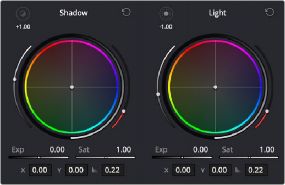
< Previous | Contents | Next >
Each individual zone also has controls for Color Balance and Saturation, which let you make focused adjustments that fall within specific ranges of image tonality, all without needing to use a qualifier. Using all of these zones together, you can make fast, precise, and smooth adjustments to the image that feel incredibly natural. Despite the name of the palette, this allows careful adjustment of SDR images, as well as creative adjustment of the spectacular range of highlights that HDR enables. There are also Range and Falloff controls to the left and right of each cluster of controls that let you redefine each zone’s area of influence, even if the Zone graph is hidden.

The Shadow and Light zone controls next to one another; you can see the Min and Max
indicators, along with the Range value (in stops) at the upper left of each group of controls.
— Range indicator: An icon and value at the upper-right-hand corner of each zone control cluster shows that zone’s range. A numeric value shows the range value, which is the Luminance level of image tonality at which that zone’s adjustment begins. This value is expressed in stops, while an icon shows you whether it’s a maximum range (affecting shadows) or a minimum range (affecting highlights).
— Clicking the icon shows a temporary preview in the Viewer of which parts of the image will be affected by the controls of that zone. Affected areas appear in full color, while unaffected areas appear black.
![]()
— Zone-specific Color Balance: A color balance control lets you readjust the relative strength of the red, green, and blue channels within the current zone of image tonality.
— Zone-specific Exposure: Zone-specific Exposure controls work in conjunction with an adjustable pivot that defines the Luminance level that each exposure adjustment starts from. To accommodate both shadow and highlight adjustments, there are two kinds of pivots, labeled Maximum and Minimum range, and indicated using an icon. Max Range controls, such as the
Shadow control, start at a maximum value with exposure adjustments stretching image contrast downward towards the shadows. Min Range controls, such as Light, start at a minimum value with exposure adjustments stretching contrast upwards towards the highlights. Each zone also has a falloff that specifies how much of that zone overlaps neighboring zones (starting at the pivot level) in order to blend overlapping adjustments softly enough to prevent contouring.
— Zone-specific Saturation: Adjusts the intensity of color within the current zone of image tonality.
— Min/Max Range: Defines the level of image tonality at which that zone’s adjustment starts. This value is expressed in stops. Identical to the Min or Max Range slider in the Zone panel. Useful for tweaking Range while the Zones graph is hidden.